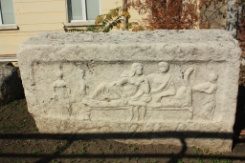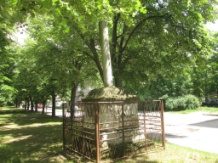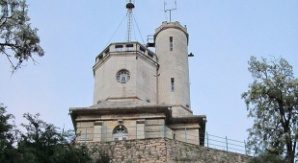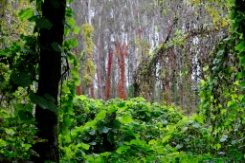

Prista Sexaginta is located in the modern northern city of Ruse, above the Danube River. The fortress was located at the end of the nineteenth century by Felix Cadiz, based on distances between cities marked on the maps with Roman routes.
The first information about the castle and the remains of this we have achieved in the early twentieth century, from brother Shkorpil. Under construction and excavation of the Military Club, there were remnants of the city, but archaeological research took place during 1976-1978 and 2005-2006. As a result have been discovered about 50% of the northwest wall of the city and the tower, six buildings, Apolo’s and Principia Temple – Headquarters of the military unit from Sexaginta Prista. The conservation of structures discovered in 1976-1978 was conducted and in 2002 was opened the exhibition of discovery “Prista Sexaginta”. În In the past years since then, the the objective was socialized and now is among the visited museums.
The traditional city name is translated as „The port of those 60 ships”. After analyzing all available sources, it was established that the castle got its name linked to the events of the early century, namely, the Dacian wars of emperor Domitian (85-89). Then the Danube River, at the mouth of the river Rusenski Lom, a Roman legion was transferred made up of around 6,000 people. Exactly 60 Pristis type ships were needed for this action.
In the honor of the victory over the Dacians, the castle has received its new name. Perhaps by then, the Thracian fortress was named by the river Rusenski Lom. The first known written and epigraphic sources until now of Sexaginta Prista are from the beginning of the II century. Until now it was assumed that, on the territory of the castle, there was a Thracian settlement, unfortified during the third century before Chr. until the arrival of the Romans. The latest studies prove unquestionably that the crest was the place where Thracians were carrying religious rituals and practices unknown to us. Vestiges of this activity are hundreds of holes of which, until now, have been researched about 50. The Thraciancomplex of holes date back in the Ist century BC – first century AD. The place was an important religious center, and its position is not far from the settlement (about 500 m), has important commercial and political functions. This period is among the least researched archaeological periods in Bulgaria. The the holes were descovered a lot of pottery, bronze objects, coins, bones and other finds. Some of the dishes were pt in the holes in whole. The zoomorphic vessel with a rich incised decoration and polished, finished with an eagle head. is unique.
Among the remaining materials, some (fibulae and others), which are usually met in Western Europe are highlighted. The researches in 2005/2006 prove that the first Roman military camp (late first century until the late third century) was not in the investigated area. Its place was not revealed yet, but may be located at the mouth of the river Rusenski Lom, further from the late ancient fortification. The vestiges of the hilltop, during the centuries II-III a are civilian buildings, possibly a camp on the edge of the settlement, especially as a center of worship. There have been studied the remains of several buildings. One is the temple of Apollo, were were discovered four entire votive plaques and fragments belonging to the THracian Horsemann and to Apolo, pottery, coins and other discoveries. In the same place was discovered the Apollo’s altar with an inscription. Interesting is the plan of the temple discovered. It is oriented northeast – southwest and according to the sources it looks like a christian churh. The closest parallels to such pagan temples are in Ruchey village, Krumovgrad; Benwel, Anglia, and Porolissum in Dacia (România). The temple descovered is the proof of the loan from the wounds of Christian and construction plans of the pagan temples.
Te votive plates of the Thracian Horseman and Apolo were descovered in in the temple, placed in the holes. The building ceases its functions at the end of the third century and it is built over one of the most important buildings of the Roman war camp – Principia. In this period (end of third centurz – begining of the IVth century) was built the castle in late antiquity, to whom the buildings, northwest fortification wall and tower descovered in 1976-1978belongs peretele de fortificație de nord-vest și turnul. At the beginning of the fourt century, during the Constantin the Great reign, Principia castle was built and Sexaginta Prista. This is a big building, unfortuntely partially destroyed by previous constructions. However, its timeline was established – from the beginning of 80s of the IVth century. The building ceases to operate as due to riots caused by the Goths in the late fourth century. After that, it was reused until the first decades of the V century. The findings from this period are few – mainly coins and fragments of pottery. From coins discovered in the years 2005/2006, about 100 are from the fourth century.
The following chronological levels were later destroyed by an embankment and a leveling of the nineteenth century – the twentieth century. About this, we have learned from previous excavations at the chronological levels. The occupation in Late Antiquity (V-VI centuries) and the First Bulgarian State (X-XI centuries) was demonstrated according to the coins and fragmented pottery. The statement was revised regarding the existence of the fortress in the Second Bulgarian State here. The discovery of a Christian tomb and bones from other individuals allowed us to assume hypothetically that during the XII – XV centuries here was one of the necropolis area in Ruse. The following traces of living here were from the end of the XIXth century – remains of some houses, nine septic tanks and a tunnel. It is possible that it leads to Ottoman fortifications arsenal – Kark Djaim. On the top level are vestiges of the modern era (twentieth century.
Working hours: every day between 9.00 – 17.30
Entry fees: for foreigners and students – 1,00 lv., for individual visitors – 4,00 lv., fro gtoups (peste 5 oameni) – 3,00 lv., presentation in Bulgarian language – 4,00 lv.







